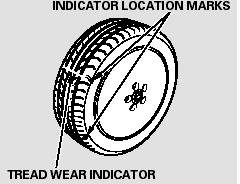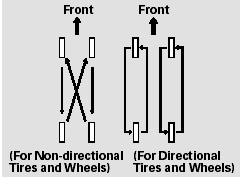Tires
To safely operate your vehicle, your tires must be the proper type and size, in good condition with adequate tread, and correctly inflated.
The following pages give more detailed information on how to take care of your tires and what to do when they need to be replaced.

Using tires that are excessively worn or improperly inflated can cause a crash in which you can be seriously hurt or killed.
Follow all instructions in this owner’s manual regarding tire inflation and maintenance.
Inflation Guidelines
Keeping the tires properly inflated provides the best combination of handling, tread life, and riding comfort.
Underinflated tires wear unevenly, adversely affect handling and fuel economy, and are more likely to fail from being overheated.
Overinflated tires can make your vehicle ride more harshly, are more prone to damage from road hazards, and wear unevenly.
The tire pressure monitoring system (TPMS) warns you when a tire pressure is low.
Even though your vehicle is equipped with TPMS, we recommend that you visually check your tires every day. If you think a tire might be low, check it immediately with a tire gauge.
Use a gauge to measure the air pressure in each tire at least once a month. Even tires that are in good condition may lose 1 to 2 psi (10 to 20 kPa, 0.1 to 0.2 kgf/cm2 ) per month. Remember to check the spare tire at the same time.
Check the air pressures when the tires are cold. This means the vehicle has been parked for at least 3 hours, or driven less than 1 mile (1.6 km). Add or release air, if needed, to match the recommended cold tire pressures on this page.
If you check air pressures when the tires are hot (driven for several miles/kilometers), you will see readings 4 to 6 psi (30 to 40 kPa, 0.3 to 0.4 kgf/cm2 ) higher than the cold readings. This is normal. Do not let air out to match the recommended cold air pressure. The tire will be underinflated.
You should get your own tire pressure gauge and use it whenever you check your tire pressures. This will make it easier for you to tell if a pressure loss is due to a tire problem and not due to a variation between gauges.
While tubeless tires have some ability to self-seal if they are punctured, you should look closely for punctures if a tire starts losing pressure.
Recommended Tire Pressures
]The following chart shows the recommended cold tire pressures for most normal and high-speed driving conditions.
| Tire Size | Cold Tire Pressure for Normal Driving |
| 225/65R17 102T | Front/Rear: 30 psi (210 kPa , 2.1 kgf/cm2 ) |
The compact spare tire pressure is:
60 psi (420 kPa , 4.2 kgf/cm2 )
For convenience, the recommended tire sizes and cold tire pressures are on a label on the driver’s doorjamb.
For additional information about your tires.
Tire Inspection
Every time you check inflation, you should also examine the tires for damage, foreign objects, and wear.
You should look for:
Bumps or bulges in the tread or side of the tire. Replace the tire if you find either of these conditions.
Cuts, splits, or cracks in the side of the tire. Replace the tire if you can see fabric or cord.
Excessive tread wear.

Your tires have wear indicators molded into the tread. When the tread wears down, you will see a 1/2 inch (12.7 mm) wide band across the tread. This shows there is less than 1/16 inch (1.6 mm) of tread left on the tire.
A tire this worn gives very little traction on wet roads. You should replace the tire if you can see three or more tread wear indicators.
Tire Service Life
The service life of your tires is dependent on many factors, including, but not limited to, driving habits, road conditions, vehicle loading, inflation pressure, maintenance history, speed, and environmental conditions (even when the tires are not in use).
In addition to your regular inspections and inflation pressure maintenance, it is recommended that you have annual inspections performed once the tires reach five years old. It is also recommended that all tires, including the spare, be removed from service after 10 years from the date of manufacture, regardless of their condition or state of wear.
The last four digits of the TIN (tire identification number) are found on the sidewall of the tire and indicate the date of manufacture (See Tire Labeling).
Tire Maintenance
In addition to proper inflation, correct wheel alignment helps to decrease tire wear. If you find a tire is worn unevenly, have your dealer check the wheel alignment.
Have your dealer check the tires if you feel a consistent vibration while driving. A tire should always be rebalanced if it is removed from the wheel. When you have new tires installed, make sure they are balanced. This increases riding comfort and tire life. For best results, have the installer perform a dynamic balance.

On vehicles with aluminum wheels, improper wheel weights can damage your vehicle’s aluminum wheels. Use only Honda wheel weights f or balancing.
Tire Rotation

To help increase tire life and distribute wear more evenly, rotate the tires according to the maintenance messages displayed on the information display.Move the tires to the positions shown in the diagram each time they are rotated.
If you purchase directional tires, rotate only front-to-back.
When the tires are rotated, make sure the air pressures are checked.
Replacing Tires andWheels
Replace your tires with radial tires of the same size, load range, speed rating, and maximum cold tire pressure rating (as shown on the tire’s sidewall).
Mixing radial and bias-ply tires on your vehicle can reduce braking ability, traction, and steering accuracy. Using tires of a different size or construction can cause the ABS and vehicle stability assist system (VSA) to work inconsistently.
The ABS and VSA system work by comparing the speed of each wheel.
When replacing tires, use the same size originally supplied with the vehicle. Tire size and construction can affect wheel speed and may cause the system to activate.
It is best to replace all four tires at the same time. If that is not possible or necessary, replace the two front tires or two rear tires as a pair.
Replacing just one tire can seriously affect your vehicle’s handling.
If you ever replace a wheel, make sure that the wheel’s specifications match those of the original wheels.
Also be sure you use only TPMS specific wheels. If you do not, the tire pressure monitoring system will not work on that tire.
Replacement wheels are available at your dealer.

Installing improper tires on your vehicle can affect handling and stability. This can cause a crash in which you can be seriously hurt or killed.
Always use the size and type of tires recommended in this owner’s manual.
Wheel and Tire Specifications
Wheels:
17 x 6 1/2J
Tires:
225/65R17 102T
Winter Driving
Tires marked ‘‘M + S’’ or ‘‘All Season’’ on the sidewall have an allweather tread design suitable for most winter driving conditions.
For the best performance in snowy or icy conditions, you should install snow tires or tire chains. They may be required by local laws under certain conditions.
Snow Tires
If you mount snow tires on your vehicle, make sure they are radial tires of the same size and load range as original tires. Mount snow tires on all four wheels. The traction provided by snow tires on dry roads may be lower than your original tires.
Check with the tire dealer for maximum speed recommendations.
Tire Chains
Mount tire chains on your tires when required by driving conditions or local laws. Install them only on the front tires.
Because your vehicle has limited tire clearance, Honda strongly recommends using the chains listed below, made by Security Chain Company (SCC).
Cable-type: SCC Radial Chain TC2111MM

Using the wrong chains, or not properly installing chains, can damage the brake lines and cause a crash in which you can be seriously injured or killed.
Follow all instructions in this owner’s manual regarding the selection and use of tire chains.
When installing cables, follow the manufacturer’s instructions, and mount them as tight as you can.
Make sure they are not contacting the brake lines or suspension. Drive slowly with them installed. If you hear them coming into contact with the body or chassis, stop and investigate. Remove them as soon as you begin driving on cleared roads.

Traction devices that are the wrong size or improperly installed can damage your vehicle’s brake lines, suspension, body, and wheels. Stop driving if they are hitting any part of the vehicle.
See also:
Parking
Always use the parking brake when you park your vehicle. Make sure the parking
brake is set firmly, or your vehicle may roll if it is parked on an incline.
Set the parking brake before you put the ...
Turn Signals
The turn signals can be used when the ignition
switch is in ON .
■ One-touch turn signal
When you lightly push up or down and release
the turn signal lever, the exterior turn signals
and ...
Playing the AM/FM Radio (EX-L model with navigation system)
Playing the AM/FM Radio (EX-L model with navigation system)
Voice Control System
The audio system can also be operated by voice control. See the navigation system
manual for complete details.
T ...






